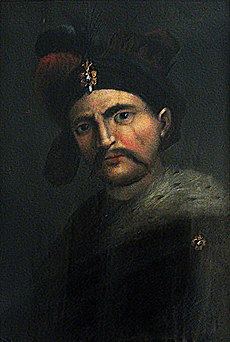Abbas the Great
| Shah Abbās the Great شاه عباس بزرگ |
|
|---|---|
| Shahanshah of Iran |
|
 |
|
| Shahanshah of Iran | |
| Reign | 1 October 1588 – 19 January 1629 |
| Coronation | 1588 |
| Predecessor | Mohammad I |
| Successor | Safi |
| Born | 27 January 1571 Herat (At that time in Iran and now in Afghanistan) |
| Died | 19 January 1629 (aged 57) Mazandaran, Iran |
| Burial | 1629 Kashan, Iran |
| Dynasty | Safavid |
| Father | Mohammed Khodabanda |
| Mother | Khayr al-Nisa Begum |
| Religion | Shia Islam |
Shāh Abbās the Great or Shāh Abbās I of Persia (Persian: شاه عباس بزرگ; 27 January 1571 – 19 January 1629) was the 5th Safavid Shah (king) of Iran, and is generally considered the strongest ruler of the Safavid dynasty. He was the third son of Shah Mohammad Khodabanda.
Although Abbas would preside over the apex of Iran's military, political and economic power, he came to the throne during a troubled time for the Safavid Empire. Under his weak-willed father, the country was riven with discord between the different factions of the Qizilbash army, who killed Abbas' mother and elder brother. Meanwhile, Iran's enemies, the Ottoman Empire (its archrival) and the Uzbeks, exploited this political chaos to seize territory for themselves. In 1588, one of the Qizilbash leaders, Murshid Qoli Khan, overthrew Shah Mohammed in a coup and placed the 16-year-old Abbas on the throne. But Abbas was no puppet and soon seized power for himself.
Under his leadership, Abbas created numerous opportunities for thousands of Circassians, Georgians, and Armenians to join the civil administration and the military. With the help of these newly created layers in Iranian society (initiated by his predecessors but significantly expanded during his rule), Abbas managed to completely crush and diminish the power of the Qizilbash in the civil administration, the royal house and the military. These actions, as well as his reforms of the Iranian army, enabled him to fight the Ottomans and Uzbeks and reconquer Iran's lost provinces. By the end of the 1603-1618 Ottoman War, Abbas had regained possession over Transcaucasia and Dagestan, as well as swaths of Eastern Anatolia and Mesopotamia; the latter two were territories which had been lost as a result of the 1555 Peace of Amasya. He also took back land from the Portuguese and the Mughals and expanded Iranian rule and influence in the North Caucasus, beyond the traditional territories of Dagestan.
...
Wikipedia
